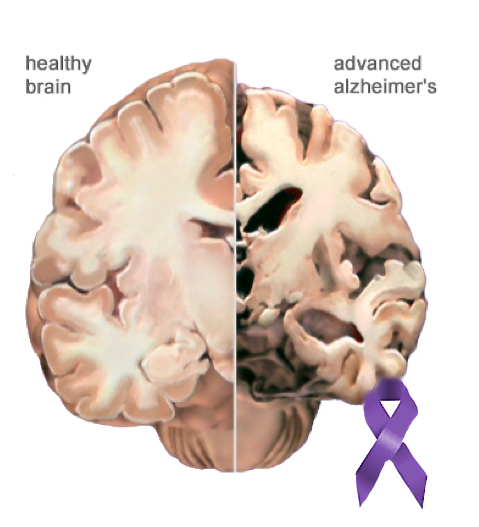Alzheimer’s Disease or Caregivers’ Disease?

Alzheimer’s Disease effect on the brain and the AD ribbon
Every 70 seconds someone in America develops Alzheimer’s Disease, and by the year 2050, it is estimated that it will develop in one person every 33 seconds. Right now, more than five million people in the U.S. have this disease.
The symptoms of Alzheimer’s Disease are both cognitive and psychiatric. The disease originates in the hippocampus of the brain (involved in memory forming) and results in neuron death and synapse destruction. Put simply, that means cell death ensues. Alzheimer’s is caused by a combination of genetic and environmental factors and is incurable.
A patient could have amnesia (loss of memory), aphasia (inability to communicate properly), apraxia (inability to perform pre-programmed motor tasks), and agnosia (inability to correctly recognize senses), along with depression, hallucinations, and personality changes. They can’t recognize their loved ones, don’t remember what they ate for breakfast, and need help with as simple a task as brushing their teeth. They need constant care.
Caregivers for patients provide over 17.5 billion hours of care and many are not paid. According to the Alzheimer’s Association, more than $203 billion was the direct cost of caring for those with the disease in 2013. Also reported was more than 60% of caregivers of Alzheimer’s have high emotional stress, and one third have signs of depression because of the emotional impact of caregiving.
15% of caregivers are long-distance, which is inefficient for them and they become less available for the patient. Alzheimer’s is not only tremendous burden on the patients, but on society itself– financially and emotionally.
In ‘Muffett’s Story’, shared by alz.org, a caregiver describes her heart-wrenching experience taking care of her mother: “Everything is secondary when you are a caregiver. Your life is forfeited, and because this battle cannot be won, you will ultimately fail. There is simply no way to put a good face on this experience.” She was unable to have a future, or a life of her own.
The National Institute of Health says you can prevent Alzheimer’s by eating vegetables, fruits and whole grains, maintaining a healthy weight, and even avoiding cooking with aluminum pots and pans. But is that enough to slow the rate down enough? How well does all of that work? Ongoing studies on gene linkage with the disease could develop a cure in the future, but in this moment society needs to alter the way it takes care of this situation.
The number of Alzheimer’s patients is predicted to grow in the future, and we as a society need to prepare ourselves for that. Caregivers should not have to devote their lives to helping a person with Alzheimer’s. Instead, rotating caregivers for one patient could relieve their stress, and more support groups should be institutionalized. Alzheimer’s Disease should not take down others with it.









